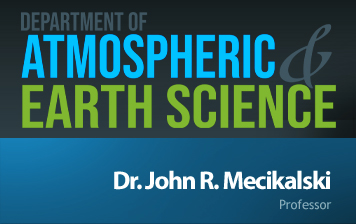Satellite-based Convective Storm & Convective Initiation Studies
Lightning Initiation & Satellite-Lightning Inter-comparison Research
 Background:
Background:
This effort constitutes two main aspects of basic research: (1) determination of lightning initiation signatures within geostationary imagery, so to assess the value in lightning initiation (LI) 0-1 hour nowcasting, and (2) developing an understanding on how radar (dual-polarimetric), satellite and lightning-mapping array data are inter-related in space and time.
Within cumulus cloud fields that develop in conditionally unstable air masses, only a fraction of the cumuli may eventually develop into deep convection. Identifying which of these convective clouds is most likely to generate lightning often starts with little more than a qualitative visual satellite analysis. The goal of this study is to identify the observed satellite infrared (IR) signatures associated with growing cumulus clouds prior to the first lightning strike, so–called lightning initiation (LI). This study quantifies the behavior of ten Geostationary Operational Environmental Satellite (GOES–12) IR interest fields in the 1-hour in advance of LI. A total of 172 lightning–producing storms that occurred during the 2009 convective season are manually tracked and studied over four regions: Northern Alabama, Central Oklahoma, the Kennedy Space Center and Washington D.C. Four–dimensional and cloud–to–ground lightning array data provide a total cloud lightning picture (in–cloud, cloud–to–cloud, cloud–to–air, cloud–to–ground) and thus precise LI points for each storm in both time and space.
Ongoing research is also diagnosing MSG and lightning mapping array (LMA) fields for lightning versus non-lightning producing storms over the NAMMA field-experiment region in equatorial Africa. Results of this effort are pending.
Main Results
Upon the examination of 172 LI events over the four LMA networks in GOES IR LI interest fields (IFs), 8 out of 10 LI IFs considered have at least some unique value in identifying LI across all regions. Statistical significance tests were performed as a means of quantifying IF uniqueness. Similar to Siewert (2008), we drew specific IF median values from the results above, as shown in Table 1. These median-value LI results are shown along with the MB06 CI thresholds (based on examination of many events, including null CI cases, which was not done here); therefore, the MB06 results can only be qualitatively compared to those found in Siewert (2008) and outward of this study. These results are applicable for evaluation within a real–time satellite–based system that monitors for LI.
The 15–min TB39107 trend and the ref39 trend are the two fields that showed relatively little unique value when GOES IR data were analyzed in advance of LI (hence why 8 of 10 LI IFs are considered valuable). Additionally, the 15–min TB65107 and TB133107 time trends did not provide much added information. Overall, the 15–min trend IFs provide more awareness to imminent LI. Most fields appear fairly predictive at 15 to 45 min before LI, with an average lead–time for all fields and regions near 35 min.
Given the roughly 35–min average lead–time for LI the IFs provide, use of the IF medians and means for LI–15 to LI–30 min determines the values in Table 1. The LI IF values found here are less restrictive than Siewert’s (2008) LI values for two reasons: (1) Siewert (2008) examined convective storms only ≤15 min before LI. Since the LI–0 and LI–15 median values in this study match Siewert’s IF values very closely, we feel these two studies corroborate the hypothesis that GOES IR IFs can indeed be used to predict LI. And, (2) this present study makes use of a much larger dataset of LI events (172 versus ~12). With a small database, more extreme values are expected, while smoothing of extreme values occurs as more events are included.
Individual LI cases appear to have very similar tendencies, as for example with the TB39107 and TB133107 15–min trends. However, our analysis noted that the largest tendencies often occur at different times in a storm’s development, which is likely related to conditions in the ambient environment of a given storm (e.g., instability, the shape of the instability, water vapor profiles). Therefore, use of IFs that appear to provide similar information over a population of events may in fact add valuable information on a case–by–case basis.

